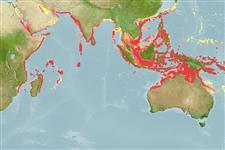>
Eupercaria/misc (Various families in series Eupercaria) >
Lethrinidae (Emperors or scavengers) > Lethrininae
Etymology: Lethrinus: Greek, lethrinia, a fish pertaining to genus Pagellus.
More on author: Valenciennes.
Environment: milieu / climate zone / depth range / distribution range
Οικολογία
Θαλασσινό(ά) Υφαλόφιλο(α); μη μεταναστευτικό(ά); εύρος βάθους 10 - 200 m (Ref. 2295). Tropical; 32°N - 23°S, 32°E - 160°E
Indo-West Pacific: widespread, including the Red Sea, Arabian (Persian) Gulf, East Africa to Sri Lanka, to the Ryukyu Islands and Papua New Guinea. Also recorded from Micronesia (Ref. 3807) and French Polynesia (Ref. 4517) but these are probably misidentifications of Lethrinus olivaceus.
Length at first maturity / Μέγεθος / Βάρος / Age
Maturity: Lm 29.1 range ? - ? cm
Max length : 80.0 cm TL αρσενικό/απροσδιόριστο; (Ref. 48635); common length : 40.0 cm TL αρσενικό/απροσδιόριστο; (Ref. 2295); μεγ. δημοσιευμένο βάρος: 4.9 kg (Ref. 40637)
Ραχιαίες άκανθες (συνολικά) : 10; Μαλακές ραχιαίες ακτίνες (συνολικά) : 9; Εδρικές άκανθες: 3; Μαλακές εδρικές ακτίνες: 8. The snout is moderately long, its dorsal profile slightly concave. Body color is bluish gray or brown often with scattered irregular dark blotches on sides; sometimes three dark streaks radiate forward from the eye. The fins are pale or orangish.
Found over sandy areas near coral reefs (Ref. 30573). Feeds on fish, crustaceans, cephalopods, and polychaetes. Swims in small schools sometimes together with L. olivaceous. Utilized as a food fish. Maximum depth reported taken from Ref. 9773.
Life cycle and mating behavior
Γεννητική Ωρίμανση | Αναπαραγωγή | Γεννοβολία | Αβγά | Γονιμότητα | Προνύμφες
Carpenter, K.E. and G.R. Allen, 1989. FAO Species Catalogue. Vol. 9. Emperor fishes and large-eye breams of the world (family Lethrinidae). An annotated and illustrated catalogue of lethrinid species known to date. FAO Fish. Synop. 125(9):118 p. Rome: FAO. (Ref. 2295)
IUCN Red List Status (Ref. 130435: Version 2024-1)
Threat to humans
Reports of ciguatera poisoning (Ref. 31637)
Human uses
αλιεία: Εμπορικό(ά); αλιεία αναψυχής: ναί
Εργαλεία
Special reports
Download XML
Διαδικτυακές πηγές
Estimates based on models
Preferred temperature (Ref.
123201): 24.7 - 29.1, mean 28.1 °C (based on 1954 cells).
Phylogenetic diversity index (Ref.
82804): PD
50 = 0.5000 [Uniqueness, from 0.5 = low to 2.0 = high].
Bayesian length-weight: a=0.01175 (0.00760 - 0.01816), b=2.97 (2.85 - 3.09), in cm total length, based on LWR estimates for this species & Genus-body shape (Ref.
93245).
Τροφικό Επίπεδο (Ref.
69278): 3.8 ±0.51 se; based on food items.
Generation time: 5.5 ( na - na) years. Estimated as median ln(3)/K based on 2
growth studies.
Ελαστικότητα (Ref.
120179): Μεσαίο(α), ελάχιστος χρόνος για διπλασιασμό πληθυσμού 1,4 - 4,4 έτη (K=0.20).
Prior r = 0.57, 95% CL = 0.37 - 0.85, Based on 1 data-limited stock assessment.
Fishing Vulnerability (Ref.
59153): Moderate to high vulnerability (46 of 100).
Climate Vulnerability (Ref.
125649): Very high vulnerability (89 of 100).
Nutrients (Ref.
124155): Calcium = 30.8 [21.6, 41.5] mg/100g; Iron = 0.726 [0.499, 0.997] mg/100g; Protein = 20.3 [17.7, 22.4] %; Omega3 = 0.124 [0.092, 0.165] g/100g; Selenium = 51 [27, 76] μg/100g; VitaminA = 25.1 [5.6, 129.2] μg/100g; Zinc = 1.81 [1.40, 2.24] mg/100g (wet weight); based on
nutrient studies.
